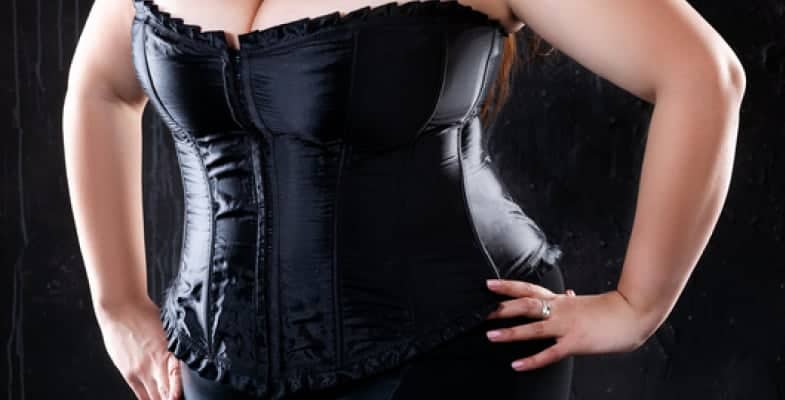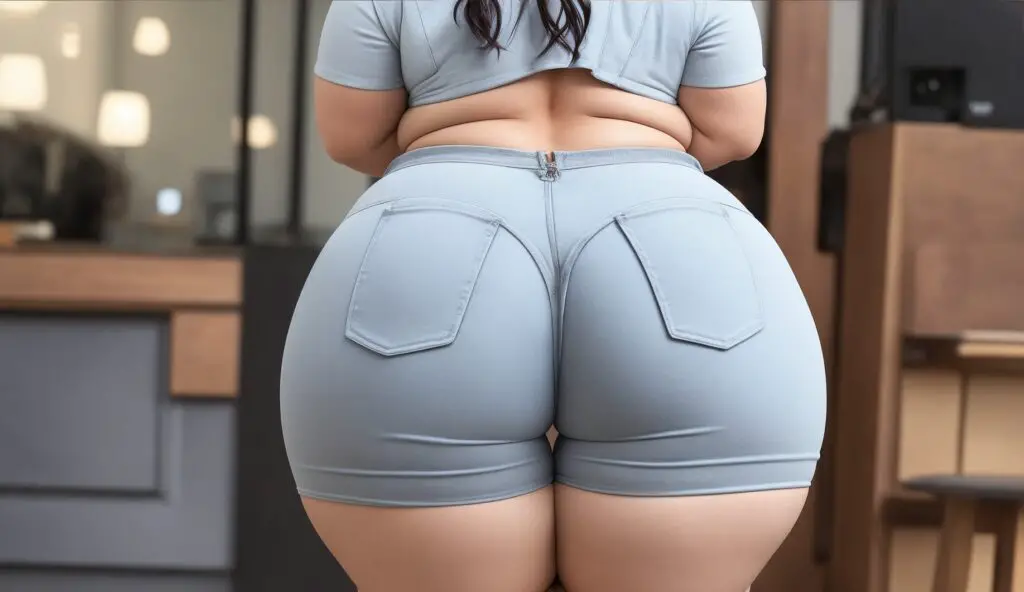There so many varying opinions on plus size waist trainers used by full-figured women, we absolutely had to create an article about “Plus Size Waist Trainers: Our In-Depth Review”. So, let’s start at the very beginning.
What is a Waist Trainer and What do They do?
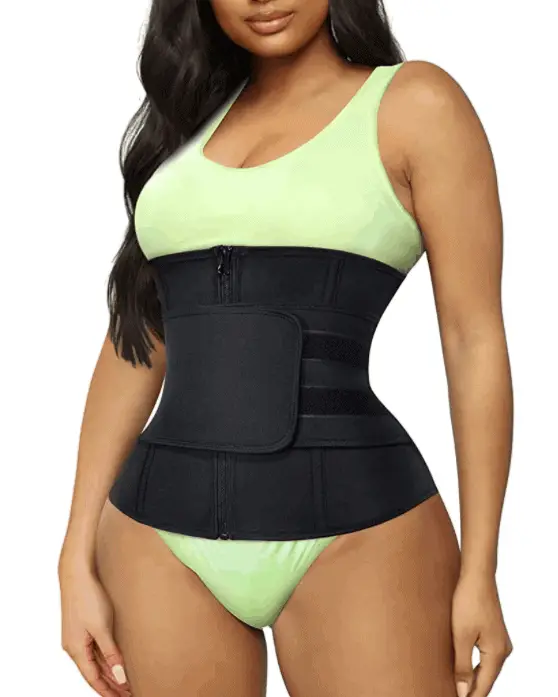
Definition: Waist Trainer – “The idea behind waist training is that, by wearing a steel boned corset, fat pockets along the waist and floating ribs (the two lowest ribs that aren’t connected to the breastbone) will be molded into a trimmer hourglass figure.” (Jill Didonato. March 2020)
There are pros, cons, and everything in between. Celebrities, doctors, and us normal folk who use them all have an opinion. Some say it’s not only healthy and safe, but it also does what waist trainers claim to do. Some say it’s not really going to hurt you, but it doesn’t really do anything. And lastly, there are those that say it’s dangerous and show no real results. It’s always good to do some research before committing so something like waist training.
Waist Trainer Fun Fact: The corset was created by women in order to avoid punishment when a ban was put on “thick waists” when King Henry 2 ruled France in the 1550s. (Emma Richards, October 5, 2015: omg-waist-trainer.com)
When Was the First Corset Invented?
According to Wikipedia, The corset first became popular in sixteenth-century Europe. The corset reached its highest popularity during the Victorian era. Since then corsets have changed. Of course, those types made way back when are still available and sometimes even recommended still today for certain people. Women may not use them now because they’re forced to by some ridiculous law, but because they desire a certain shape. So, in all, the idea is mostly the same, but we have an advantage with the varieties available.
What are the Pros and Cons to Waist Training?
According to an article written by Lees Garcia (for the website thekewlshop.com), waist trainers have both good and bad qualities.
Pros
- Having constant constriction from the corset causes your natural waist to reduce over a period of time. It’s really a lifestyle to some.
- Plus size women use waist trainers in order to obtain that hourglass figure that women everywhere tend to try and achieve.
- Waist trainers don’t help you burn more fat, but it does help restrict the amount you eat.
- As a lot of people may know, waist trainers also claim to help with posture by providing more necessary support to your back.
Cons
- Wearing a waist trainer when you eat can cause acid reflux and hamper proper digestion.
- It can cause health problems if you push it too far. It’s important to understand that it’s a gradual process.
- If you wear a corset too tight it can make breathing harder. It shouldn’t squeeze the breath out of you.
- A waist trainer that’s too tight for too long will actually reduce your core strength.
Does Waist Training Really Work for Plus Size Women?
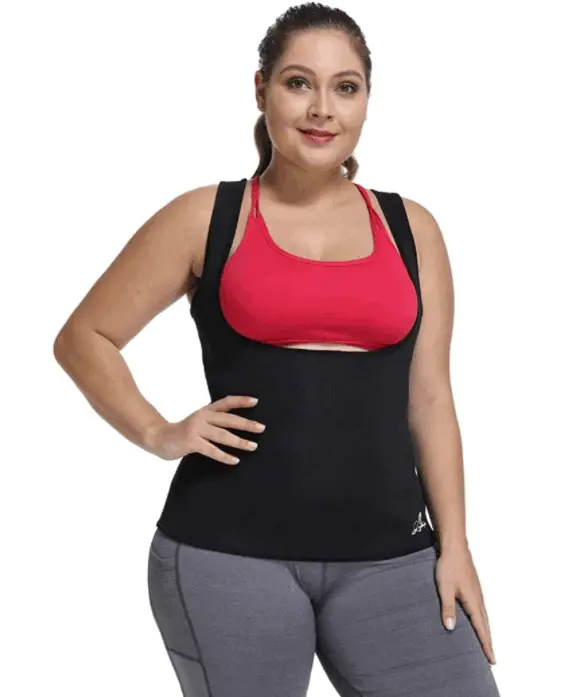
After evaluating the good and the bad, I hope you can sort of tell which way you lean on this subject. It’s really important to full figured women to remember that they’re beautiful just the way they are and don’t need to use a waist trainer to make themselves look different. As a full-figured woman, I do understand why even “normal” (what even is that anyway) sized women use these.
When you wear a waist trainer it does help you decrease the volume of food that you eat. Doctors recommend a routine of five small meals a day verses three larger meals per day. This helps keep your metabolism going. The more your metabolism has to kick in, the more you burn. Of course, it’s still important to watch what you’re eating, but at least there’s something to help us control those munchie moods.
Waist Trainer Fun Fact: “Corsets and shapers became popular around the 1600s and women wore them in some shape or form for centuries afterward, often starting in their mid-teens.” (Kara Nesvig, May 16, 2016: eliteddaily.com)
What are plus size waist trainers made out of?
With waist trainers, there are so many different designs, fabrics, and measurements. They are supposed to compress your waist at the bottom two rib cages . They cinch the most around the smallest part of your waist and the longer you wear it, the more you’ll see results. Waist trainers also help accentuate your bustline and hips. Although it’s said that once you stop using a waist trainer, you could very well go back to your natural shape (probably quicker than you would prefer to be honest). That’s why experts say it’s a lifestyle choice.
That being said, it sounds like this is going to be a regular thing. If it’s going to be a regular thing, then we need to make sure that it’s going to work for us. I’m sure a lot of us know that different fabrics do different things. Some breathe more and if you’re going to be wearing this on the regular, you’ll want a breathable fabric. So, what are the different fabrics and what do they all do? Here’s what a writer from hourglassangel.com says about different fabrics and what they’re for.
- Latex: Latex is stretchy but also firm. It’s known as the most high-quality waist training fabric as it’s unbeatable with the amount of compression it can give without being stretched out or worn down. If you take good care of your waist trainer (clean it regularly but don’t put it in the washer) it can last for months, even with everyday wear.
- Cotton: Some waist trainers are made with more cotton than others in order to deliver a softer, cooler feel (especially in the exterior lining). It can be lightweight and is great to wear in warm climates.
- Latex Free Blend: This blend is to help out our full figured sensitive skinned women. This fabric is hypoallergenic (us with sensitive skin thank you) and even though it’s latex free, it still holds very firm like latex. This isn’t only meant for women with sensitive skin. Some without sensitive skin could even prefer this blend of material.
- Seamless Design: If you’re looking to wear a waist trainer underneath everyday t-shirts, get one of these. There are no hooks or other thingamabobs that show through your clothes.
- Steel-Boned Corsets: Classic corsets are quite different from modern corsets. Although the goal and idea remain the same, what they’re made of is quite different. The boning in a corset is what provides its unique shape. While most corsets are made with latex, these corsets are made with a combination of satin, polyester or cotton. Cotton feels a bit cooler than other fabrics as we discussed before. While corsets are a bit pricier than a waist trainer, they can usually last longer if they’re taken care of properly.
Wouldn’t it be nice if we could just combine all the benefits of all of these fabrics and materials to make one super waist trainer. It was a long shot, but what’s a girl to do? It seems like a lot of effort and thinking goes into modern day waist trainers. We’re all just working to improve, and this community is not excluded. The wearing of waist trainers has exploded since celebrity, Kim Kardashian, was seen wearing one under a dress at some fancy red-carpet event. She seems to set off trends left and right.
It would be nice if life was a little simpler but exploring the world of waist trainers has proven to be quite insightful. Seeing why different full-figured women use waist trainers created a demand for a variety of different styles. Not just materials and fabrics but designs as well.
Waist Trainer Fun Fact: Cotton is the most commonly used fabric in women’s clothes because of breathability and durability. (Fashion Gone Rogue, ND, fashiongonerogue.com)
Different Body Types and Why They Need Different Waist Trainers.

In an article written by homecandy.com, they state why its important to take your body type into consideration before purchasing a waist trainer.
“Waist trainers are popular and effective ways to help sculpt your body into a form you feel to be ideal. When considering the best waist trainer for your goals it’s important to first consider which body type category you fall into. This may be the pear-shape, rectangular shape, inverted triangle—or maybe somewhere in the middle. We’ll share how to first measure your body to understand which body shape you are and then how to use those measurements to pick out the best waist trainer for you! – homecandy.com
Full figured women everywhere are learning to embrace their shape. Shopping as a plus size woman can be really hard though depending on your shape. The full-figured fashion industry really needs to start looking at the women they’re designing for.
That being said, if you’re a full-figured woman, you know how important your shape is. When we shop, we look for things that we know accentuate our natural shape. We talk about that in our article Best Plus Size Top Styles That Hides Your Stomach. A lot of us avoid horizontal stripes as they made us look wider, while other women love stripes because it gives their curves that extra vavoom! Same goes for waist trainers’ ladies. One size surely does not fit all. Can I get an amen?
Some of us more apathetic souls may not know what type of body shape we even have. We just see us. Homecandy.com provides a way to determine what body shape you have by using some simple math.
- Use a measuring tape to measure all the way around your:
- Shoulders: have someone help you measure around the widest part of your shoulders.
- Bust: Like with a bra, measure around the largest part of your bust, but don’t squeeze until your squishing that measuring tape into yourself.
- Waist: Measure around the smallest part of your natural waist, usually just above your belly button. Again, don’t pull so tight that your squishing yourself.
- Hips: Start below one hip bone and wrap the tape around the largest part of your rear end.
Well done! Measurements? Check! Now, what’s the magic formula that gives us our body type without staring at ourselves in a mirror for hours on end. Or sending our friends endless texts asking for opinions, just me?
- Use these formulas and tips to determine your shape:
- Inverted Triangle Body Shape
- The features of this body type usually have flat hips, squared shoulders, and midsection.
- Here’s the math you’ve been waiting for: Use the shoulder measurement and divide it by your hip measurement. If the number from that equation is bigger than 1.05, you have an inverted triangle body shape.
- Rectangular Body Shape
- The features of our rectangular women are smaller bust, narrow shoulders, and narrow hips.
- The equation for this body type is achieved by dividing your waist measurement and your shoulder measurement. If the number you come up with is above .75, you have a rectangular body shape.
- Pear Body Shape (a.k.a triangle)
- The features of the pair shape tend to be full hips, your shoulders are narrower than your hips and you have a well-defined waist.
- Follow this equation to see if you are pear-shaped: Divide your shoulder measurements by your hip measurements. If the number you get from that is bigger than .75, congratulations, you’re pear-shaped.
- Inverted Triangle Body Shape
We’re digging deeper y’all, let’s see what each shape benefits from a waist trainer!
Triangle: Since your hips aren’t as wide as your shoulders (your waist goes slightly in) it can be hard to balance your upper body with the rest of you. So, you’re going to usually gravitate towards clothing that slims you in the hip area and accentuate your curves.
Rectangular: Being that your shoulders and hips are an equal width, you would benefit from a body suit that pushes up your bust, pulls in your mid-section and accentuates your hips and rear end. A waist trainer that is made for this shape is best.
Pear: Your shoulders are narrower than the widest part of your hips so bringing your waist in just a little bit more will bring out your natural curves even more.
I’m not trying to sound like a broken wound up clock but including these types of ideas in your search for the perfect waist trainer for your body will help you get the one you need asap. No need to go through three returns or more in order to get what you’re looking for.
Now that we’ve got all that out of the way, more questions need answering. We know what waist trainers do, we know what different materials there are to choose from, we know what shapes we are, and we know why it matters to choose a waist trainer made for our own shape. So, we’ve got the waist trainer in our hands. We put them on and go about our day. Days go by and here we are wondering how long this is going to last.
How Long or How Often Should I Wear a Waist Trainer?
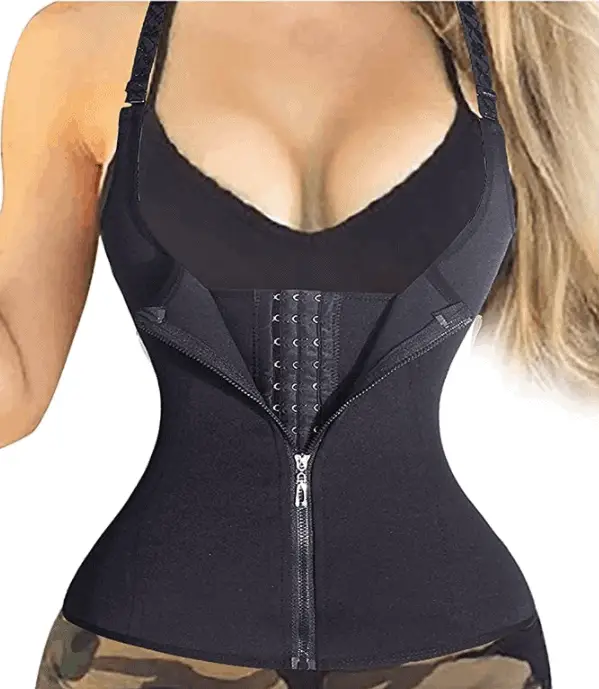
We are all different. I’m pretty sure I’ve probably reiterated that enough, but I’m going to keep saying it. We all have different lifestyles, goals, time frames, etc. So, the answer is not a one size fits all kind of question. If you have more time in your day, you’ll be able to wear it more. If you can wear a waist trainer under work clothes, then you’ll see results sooner. It all depends on your circumstances.
There is a phrase known in the waist training community called seasoning. According to nicoletteshapewear.com seasoning is the build up of time that you can wear a waist trainer. It’s not good to just jump in and wear one all day. The writer also states that your diet, lifestyle, and your genetics all play a part in determining how long and often you should wear a waist trainer.
As I mentioned before, seasoning is an important step in your waist training journey. Because that’s exactly what this should be, a journey. There are ways to get hurt doing this and no body wants that. So, knowing that you’re a beginner is key and using self-control couldn’t be wiser right now. Make yourself a schedule. Maybe wear it for no more than two hours and see how you feel. If you genuinely feel ok, then bump it up by an hour the next day. Once you notice some resistance, you should take note and keep up with that many hours as often as you can.
Also take into consideration that you don’t have to wear it in just one sitting. Think about separating your waist training time. Do one half in the morning and one half later in the day, or whatever works for you and your life.
Some websites, like waistsecret.com, offer beginners guides and checklists to help even the novices get started on the waist training journey. They break it down day by day. It looks like this:
- Day One: This can be adjusted to your individual needs so don’t be shy to change it up. If you feel that this is too much, try maintaining a goal of two to three hours per day for the first three days. Set a goal for two hours though if you can.
- Day Two: Set a goal of four hours today. If this gets too constricting, don’t be afraid to cut the time short. Remember that it won’t help you complete this goal if you push yourself too far and get hurt. If you’re hurt, you can’t waist train at all. Which pushes your goals back and so on. Just be nice to yourself.
- Day Three: Set a training time limit of six hours today. If you’re becoming more accustomed to your waist trainer, you can bump your time up to eight hours. Just as long as you’re doing well.
- Day Four: By now, you can wear your waist trainer for eight hours a day. Don’t forget, the longer your wear this, the more you’re going to be eating while you’re wearing it. By now you might notice that you’re not eating as much at once. You could be eating less more frequently, which has been found to be best for health.
- Day Five: Set a goal for nine hours of wear today. You might notice that this lifestyle change has spread to other areas of your life. You might be paying more attention to what you eat. The harder we work the more motivation we have to keep going. As long as you feel good and you’re doing well, keep going sis!
- Day Six: Your target time is ten hours today. You could be noticing that your waist trainer is getting a little loose. Don’t forget to be evaluating the fit of your trainer because you might be ready to level up!
- Day Seven: Keep your ten hour a day target. You’ve done it! You’ve made it seven days. Well done! Remember that this is going to have to continue to be a regular thing, as results from waist trainers tend to fade away the longer we go without wearing it.
Amazon has a multitude of waist trainers you can browse through including Brocades. Target also carries a healthy selection of body shapers.
Waist Trainer Fun Fact: Did you know that you spend half the time you’re awake doing automatic behaviors. Speaks to the importance of forming habits. (Niklas Goke, October 8, 2015, medium.com)
Will Wearing a Waist Trainer Interrupt my Everyday Life?
If you’re the queen of questions like myself, I’m wondering how people wear these so long. I mean; they’re driving, taking care of their pets or kids, leaning over to pick stuff up and beyond all that, working out. It sounds like a lot, but everything gets more normal over time. Even something as simple as wearing a watch or ring feels weird at first, but we adjust.
We can probably imagine that some things in our days will be affected by wearing a waist trainer. It’s going to force your posture to change, maybe for the better, which is going to make certain everyday tasks harder. You’ll adjust and everything will go back to normal so don’t fret. It’d be best if you were intentional about planning your time in the beginning of your lifestyle change though. Plan some extra time for certain physical activities in your day so you don’t end up stressed out.
Working out is probably the most active you are during your day. Although having kids or other responsibilities can feel more daunting at times (let’s be honest), you’re probably not going to be physically moving quite like you are when you’re working out. In another article written by nicoletteshapewear.com, the writer has listed a multitude of reasons why you could benefit from wearing a waist trainer to the gym or even in your own home. The benefits they mention are as follows:
- Wearing a waist trainer during your work out could help stabilize you.
- It’s a reminder to use your core during your workout.
- You’ll sweat more when you’re wearing your trainer.
- Wearing your waist trainer to the gym typically helps women stay motivated.
- Since waist trainers bring your tummy in, wearing the trainer to the gym helps hold all our jiggly bits in. Knowing that you’re not jiggling could give you a confidence boost.
I don’t know about you, but my favorite part about working out is sweating. Sweating makes me feel so much better. It helps detoxify not only our bodies but our skin as well. It’s important to remember that while the waist trainer has a job, it’s important to make sure that you’re living a healthy lifestyle. Making sure that you’re also eating a healthy diet and exercising (as a full-figured woman, it makes our doctors happy to hear that anyway so do your part as well), will only benefit you. Just do a quick evaluation of your eating and exercising habits and see if there are even small changes you can make. You can do it girl!
So, what am I Supposed to do with all of That?
You put it all together is all. Start at the top and work your way down. Remember that your health and happiness always come first. That being said, don’t get overwhelmed. Making a list of all the things you should check for should help. Some things in this article might matter more to you than others. We all also struggle in our own areas. Just remember to keep going. The longer you keep a habit, the easier it is to keep.
You’re going to get stronger eventually. Every day you should be telling yourself that if you can make it through day one and not give up (even if you had to pick up a million Legos while wearing a corset basically), you can keep going. Be proud of yourself. This is a big change, but it really could help you. Good luck on your journey! Be sure to check out our Top Picks for more.

